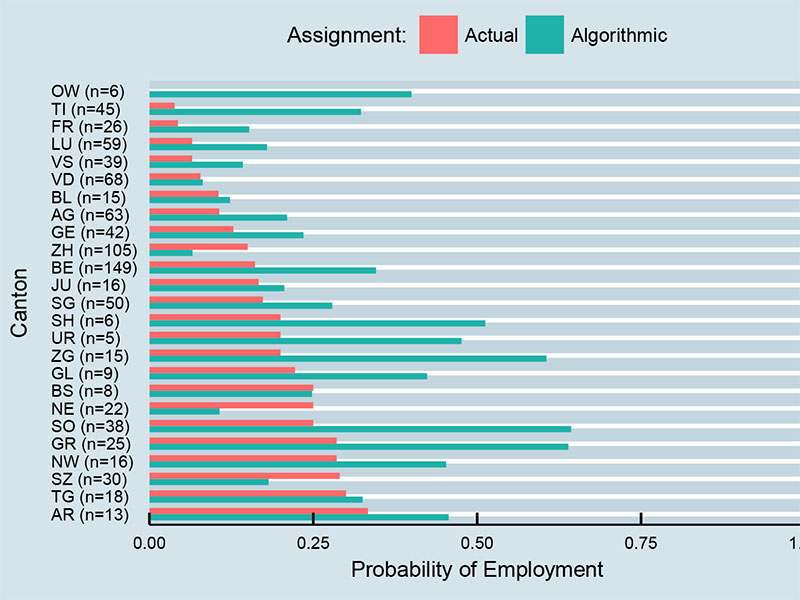Algorithm increases employment opportunities for refugees
A data-driven approach could help increase employment levels for asylum seekers in Switzerland from 15 to 26 percent. Social scientists from Switzerland and the U.S., in collaboration with ETH’s Public Policy Group, reached this conclusion in the journal Science.
Asylum seekers and refugees with subsidiary protection are allowed to work in Switzerland – but only in the canton to which they are assigned during their asylum proceedings. This allocation is based on politically defined parameters: for example, a canton’s population size is taken into account, and an attempt is made to allocate nationalities equally across cantons.
Factors such as labour market integration and the asylum seekers’ employment prospects are not taken into account. One consequence is that by their third year in Switzerland, an average of 15 percent of refugees are employed.
Optimising the allocation
In a new publication, political scientists from Stanford University and ETH Zurich found that if the canton allocation were better tailored towards the refugees’ integration into the labour market, their level of employment could be 73 percent higher than it currently is. By their third year in Switzerland, 26 percent of refugees could be working.
Their data-driven approach is based on an algorithm that they developed using machine learning methods. This algorithm can determine in which cantons the individual characteristics and abilities of particular refugees (e.g. age, gender, origins, language) best fit the specifics of the labour market (e.g. size of the agricultural sector, language region, ethnic networks).
On this basis, it makes a concrete recommendation about which canton a refugee will be most likely to find work in. The algorithm uses existing data from the State Secretariat for Migration. This dataset comprises a total of 22,159 asylum seekers who have received subsidiary protection (F-permit) and can stay in Switzerland.
Tested on real data
In order to ensure that the algorithm adequately captured current labour market conditions, the researchers used real personal and employment data from every asylum seeker who entered Switzerland between 1999 and 2012 and received subsidiary protection.
In a second step, the researchers tested the algorithm’s performance on a new sample. For the refugees who entered Switzerland in 2013, they compared the percentage who were actually employed three years later (15 percent) with the percentage of refugees that would have been employed under the algorithm’s allocation (26 percent). They therefore concluded that integration-optimised allocation could substantially increase employment opportunities for refugees in Switzerland.
Science offers constructive solutions
In the cantons of Vaud and Zurich, for example, young men from Iraq have good employment prospects. In Vaud, employment prospects are higher for anyone who speaks French. Women from Sri Lanka also have relatively good employment prospects in both cantons; both cantons have comparatively large regional networks from Sri Lanka.
“In a next step, the algorithm could be put into practice; it would be fairly straightforward to integrate it into the existing allocation process,” explains Dominik Hangartner, Professor of Public Policy at ETH Zurich and responsible for the Swiss part of the study. He adds that it could also be updated at any time if the composition of refugees and labour market were to change.
“Our goal is to use data and social sciences to propose solutions that improve the asylum process and refugees’ labour market integration. After all, having more refugees employed can also ease the financial burden on the Swiss government, cantons and municipalities.”
References
Bansak K, Ferwerda J, Hainmueller J, Dillon A, Hangartner D, Lawrence D, Weinstein J. Improving refugee integration through data-driven algorithmic assignment. Science Vol. 359 (2018), No. 6373, pp. 325-329. doi: external page 10.1126/science.aao4408.


Comments
No comments yet